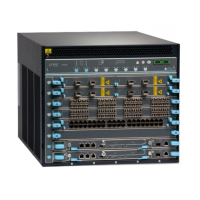port 2 {
speed 100g;
}
port 3 {
speed 40g;
}
4. Commit your configuration changes.
5. Reset the PIC.
NOTE:
Note the following when you configure rate selectability on an EX9200-12QS
line card:
•
When you boot the line card:
•
If rate selectability is not configured, all ports of the line card operate at
the default speed as four 10-Gigabit Ethernet interfaces.
•
If rate selectability is configured with invalid port speeds, all ports for
which invalid speeds were configured operate at the default speed.
•
If valid port speeds are configured, the ports operate at the configured
speeds.
•
When you changean existing port-speed configuration,for the configuration
to take effect, you must do either of the following:
•
Reset the PICs to which the configured ports belong, by using the request
chassis pic pic-slot pic-slot-number fpc-slot fpc-slot-number (online | offline)
command. Because resetting the line card takes several minutes and
because it affects all the Packet Forwarding Engines, use this command
to apply your configuration changes quickly.
•
Reset the line card
An alarm is generated indicating the change in port-speed configuration.
•
When you change an existing port-speed configuration to an invalid
port-speed configuration and commit the configuration, an alarm is
generated indicating that the port-speed configuration is invalid. The port
continues to operate at the existing port speed.
•
You cannot configure rate selectability at the PIC level and the port level
simultaneously. Error messages are displayed when you try tocommit such
configurations.
•
If you configure rate selectability at the port level, logical interfaces are
created only on the configured ports. No logical interfaces are created on
the other ports.
Related
Documentation
• EX9200-12QS Line Card on page 62
75Copyright © 2017, Juniper Networks, Inc.
Chapter 5: Line Cards

